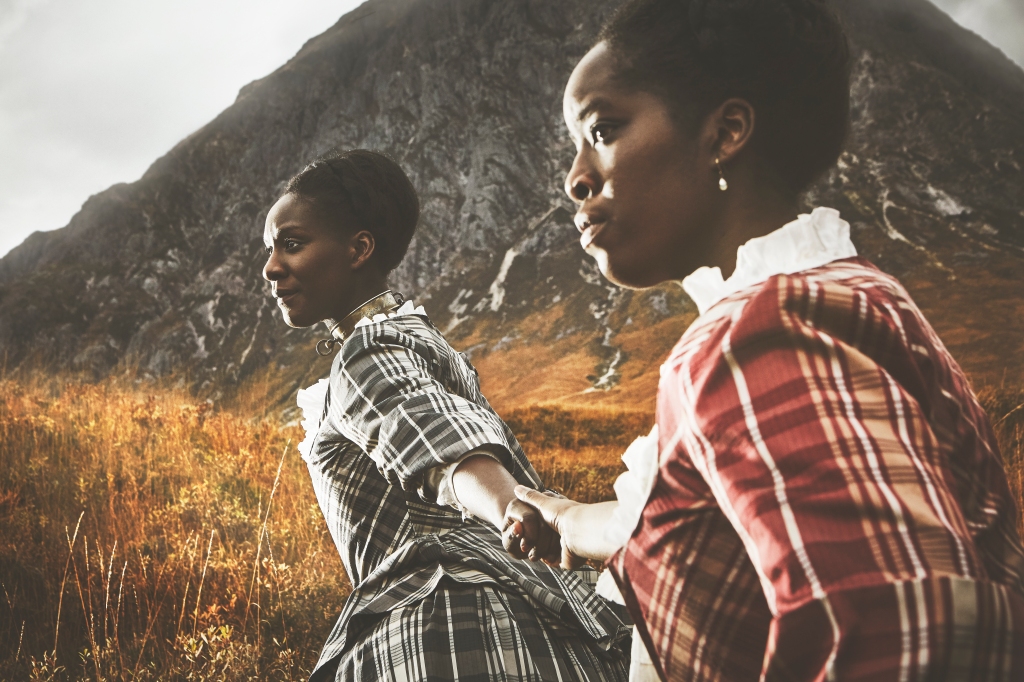The Akandé Sisters’ Multi-Award-Winning Film was based on a tragic eighteenth century reality
by Mkuu Amani

Escape.
There is no other choice, no other way.
The black night sky gives way to a soft, speckled crimson twilight, which, creeping inland from the distant horizon, throws a faint morning light by which becomes visible, just enough.
Just enough — to discern against the skyline, the dense black shadow and looming outline of the mansion that the sisters are leaving behind.
And almost enough to reveal the least hazardous route across the tenacious, green-grassed grounds and through the daunting woodlands and highlands ahead.
Such was their haste, and so frantic their actions that they carry nothing with them but the weight of their fast-beating hearts and the volume of the tartan gowns that they wear. Two sisters, to this point, enslaved, but beyond this – no more.
Claiming their freedom is now all that matters. But so much stands in their way. Not least, the wrath of Master Andrews.

By the year 1745, it is common knowledge that there are men of Scotland willing to part with their money to secure the return of their ‘runaways.’
Whether a doctor or colonel or jeweller be forthcoming, the remit remains the same. They pursue that which they attest to be their ‘property.’
Master Andrews will be no different. He will place an ad in the Glasgow Courant or the Caledonian Mercury describing the sisters as ‘negro run aways.’

Of the elder sister, it will say that ‘she is about 6 foot high, answers to the name of Emma, with a green/blue tartan gown and a brass collar bearing Master Andrews’ name about her neck.’
For the younger sister Rebecca a similar account – although hers is a red tartan dress and no padlocked neck collar is about her.
The ad may comment upon the sisters’ ability to speak good English, or Rebecca’s glistening teardrop earrings which she may attempt to sell.
And for the apprehension of each, a reward, perhaps two guineas or less.
However, if Master Andrews has his way, it’s his musket and lead ball, like the full stop at the end of an egregious sentence, that will most likely have the final say. That or some other form of punishment. Most likely, one so severe that further thoughts of escape will be discouraged or disabled.
Written by Morayo Akandé 1745 – An Untold Story of Slavery takes us back to a time in Scottish history when the nation, courtesy of the Jacobite rising, was at war with itself.
On one side, Great Britain with its concept of the united kingdoms of England, Scotland and Wales, on the other the Jacobites or ‘Followers of James’ united behind the cause of restoring the House of Stuart to the Scottish and English thrones.
And somewhere in the middle, the plight of the enslaved.
It is an era when questions of loyalty and allegiance are vital considerations. The wrong choice in the wrong place at the wrong time – could easily result in the death of the parties involved.
And as its title suggests, 1745 – An Untold Story of Slavery depicts a story that is indeed rarely told. An eighteenth-century true story brought back to life by a prodigiously talented cast and crew.

Moyo Akandé in the lead role of the enslaved Emma Atkin and her real-life sister Morayo as her enslaved sister Rebecca Atkin are a sublime on-screen combination. Clive Russell, a perfect choice for the imposing, belligerent Master David Andrews.
1745 – An Untold Story of Slavery gained nominations for Best Short Film at the Black International Film Festival (2017), British Independent Film Festival (2017), British Academy of Film and Television Arts Awards Scotland (2017) and London Short Film Festival (2018).
It also won the Writing Award at the Underwire Film Festival (2017) and gained second place for Best Short Film at the Edinburgh International Film Festival (2017).
Additionally, it won the International Short Film award at the Africa International Film Festival (2017) and Best Short Screenplay at the Seoul International Film Festival (2019).
